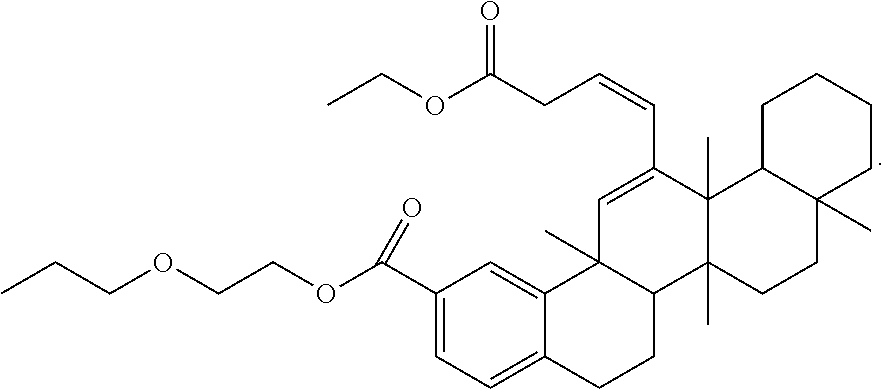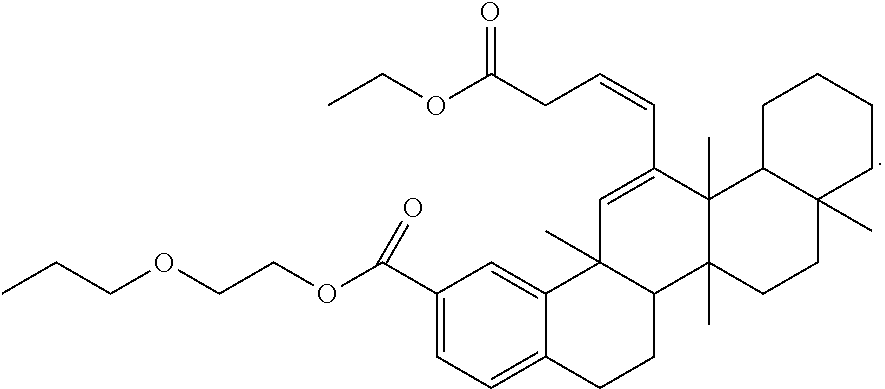Convolvulus extract for treatment of peptic ulcer and helicobacter pylori infection
- Summary
- Abstract
- Description
- Claims
- Application Information
AI Technical Summary
Benefits of technology
Problems solved by technology
Method used
Image
Examples
example 1
Isolation of Active Ingredient
[0017]The air-dried powder of 1000 g of C. pilosellifolius (aerial parts) was extracted using ethanol (95%) in a Soxhlet apparatus until complete exhaustion. The total ethanol extract was concentrated under reduced pressure at a temperature not exceeding 35° C. to yield a dry extract of 260 g.
[0018]The ethanol extract, about 240 g, was dispersed in 600 ml of distilled water and filtered using cotton piece to separate a lipid layer from other contents in an aqueous layer. The lipid layer was dissolved in chloroform, dried over anhydrous sodium sulfate, and concentrated under reduced pressure at a temperature not exceeding 35° C. to yield about 86 g of dry extract. The residue obtained was re-applied on a column packed with silica gel and eluted with hexane-ethyl acetate (95:5), from which compound A1 was isolated, Compound A1: (30 mg), pale yellow color, 0.86 in hexane-ethyl acetate (86:14), melting point: 214-216° C. 1H NMR (CDCl3): δ 7.95 (δ 1.01-1.89 ...
example 2
Preparation of Extract for Biological Testing
[0021]An extract of C. pilosellifolius was prepared according to the following procedure. The aerial parts of C. pilosellifolius were collected during flowering stage, and these parts were air dried in shade, homogenized and reduced to fine powder and kept for phytochemical and biological investigation. The dried aerial parts of C. pilosellifolius (100 g) were extracted by percolation in 90% ethanol at room temperature for two days in a Soxhlet apparatus. The ethanol extract was filtered and the residues were re-percolated for four times. The total ethanol extract was concentrated under reduced pressure at a temperature not exceeding 35° C. to yield a dry extract of 15 g. The dried extract was freshly suspended in distilled water just before administration in the following examples by the aid of Tween 80.
example 3
Determination of Median Lethal Dose (LD50)
[0022]Swiss albino mice of both sex (26-30 g) and male Wistar rats (180-200 g) were supplied by the animal house of King Saud University. Animals were housed in standard polypropylene cages with wire mesh top and maintained under standard conditions (temperature 23±1.0° C., humidity 55±10%, 12 h light / 12 h dark cycle). The mice were fed with a standard pellet diet with water ad libitum and were allowed to adapt to the laboratory environment for one week before experimentation.
[0023]Swiss albino mice in groups of six received one of 500, 1000, 2000, or 4000 mg / kg doses of the tested extract. Control animals received the vehicle only and were kept under the same conditions. Signs of acute toxicity and the number of deaths per dose within 24 hours were recorded. The total alcohol extract of C. pilosellifolius did not produce any behavioral changes or mortality in treated mice in doses up to 4000 mg / kg. Therefore, the tested plant can be categor...
PUM
| Property | Measurement | Unit |
|---|---|---|
| Dimensionless property | aaaaa | aaaaa |
| Pressure | aaaaa | aaaaa |
| Body weight | aaaaa | aaaaa |
Abstract
Description
Claims
Application Information
 Login to View More
Login to View More - R&D
- Intellectual Property
- Life Sciences
- Materials
- Tech Scout
- Unparalleled Data Quality
- Higher Quality Content
- 60% Fewer Hallucinations
Browse by: Latest US Patents, China's latest patents, Technical Efficacy Thesaurus, Application Domain, Technology Topic, Popular Technical Reports.
© 2025 PatSnap. All rights reserved.Legal|Privacy policy|Modern Slavery Act Transparency Statement|Sitemap|About US| Contact US: help@patsnap.com



